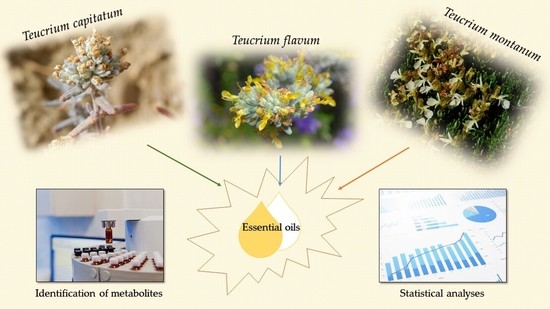The Essential Oil Compositions of Three Teucrium Taxa Growing Wild in Sicily: HCA and PCA Analyses
Abstract
1. Introduction
2. Results and Discussion
2.1. Composition of the Essential Oils
2.2. PCA and HCA Analyses of the Essential Oil Composition of Teucrium Taxa
3. Materials and Methods
3.1. Plant Material
3.2. Essential Oil Extraction
3.3. Chemical Analysis of Essential Oils
3.4. Statistical Analysis
4. Conclusions
Author Contributions
Funding
Institutional Review Board Statement
Informed Consent Statement
Data Availability Statement
Conflicts of Interest
Sample Availability
References
- The Plant List. Available online: www.theplantlist.org (accessed on 25 October 2020).
- Hollis, S.; Brummitt, R.K. World Geographical Scheme for Recording Plant Distributions; Botanical Documentation; Hunt Institute: Pittsburgh, PA, USA, 1992; ISBN 0913196568. [Google Scholar]
- Mesuel, H.; Jäger, E.; Rauschert, S.; Wienert, E. Veirleichende Chronologie der Zentraleuropäiscen Flora; VEB Gustav Fisher: Jena, Germany, 1978; Volume 2. [Google Scholar]
- Tutin, G.; Wood, D. Teucrium. In Flora Europaea 3; Tutin, G., Heywood, V.H., Burges, N.A., Moore, D.M., Valentine, D.H., Walters, S.M., Webb, D.A., Eds.; Cambridge University Press: Cambridge, UK, 1972; pp. 129–135. ISBN 9780521084895. [Google Scholar]
- McClintock, E.; Epling, C. A revision of Teucrium in the new world, with observations on its variation, geographical distribution and history. Brittonia 1946, 5, 491–510. [Google Scholar] [CrossRef]
- Dinç, M.; Doğu, S. Teucrium pruinosum var. aksarayense var. nov. (Lamiaceae) from Central Anatolia, Turkey. Mod. Phytomorphol. 2016, 9, 13–17. [Google Scholar] [CrossRef]
- Navarro, T.; El Oualidi, J.; Trigo, M.M. Polllen morphology of Teucrium (Labiatae) and its taxonomic value. Belg. J. Bot. 2004, 137, 70–84. [Google Scholar] [CrossRef]
- Melnikov, D. The System of the Genus Teucrium L. (Lamiaceae)’, Novitates Systematicae Plantarum Vascularium; Tzvelev, N., Ed.; Tomus 45; Institutum Botanicum Nomine V. L. Komarovii: Petropoli, Russia, 2014. [Google Scholar]
- Pignatti, S. “Flora d’Italia”, 2nd ed.; Edagricole-New Business Media: Bologna, Italy, 2018; pp. 210–218. ISBN 8850652445. [Google Scholar]
- Piozzi, F. The diterpenoids of Teucrium species. Heterocycles 1981, 15, 1489–1503. [Google Scholar] [CrossRef]
- Piozzi, F.; Rodriguez, B.; Savona, G. Advances in the chemistry of the furanoditerpenoids from Teucrium species. Heterocycles 1987, 25, 807–841. [Google Scholar] [CrossRef]
- Piozzi, F. Further research on the furoclerodanes from Teucrium species. Heterocycles 1994, 37, 603–626. [Google Scholar] [CrossRef]
- Piozzi, F.; Bruno, M.; Rosselli, S. Further furoneoclerodanes from Teucrium genus. Heterocycles 1998, 48, 2185–2203. [Google Scholar] [CrossRef]
- Piozzi, F.; Bruno, M.; Rosselli, S.; Maggio, A. Advances in the chemistry of furano-diterpenoids from Teucrium genus. Heterocycles 2005, 65, 1221–1234. [Google Scholar] [CrossRef]
- Ulubelen, A.; Topçu, G.; Sönmez, U. Chemical and biological evaluation of genus Teucrium. In Studies in Natural Product Chemistry. Bioactive Natural Product (Part D); Rahman, A.-U., Ed.; Elsevier Science & Technology: Amsterdam, The Netherdlands, 2000; Volume 23, pp. 591–648. [Google Scholar] [CrossRef]
- Gagliano Candela, R.; Rosselli, S.; Bruno, M.; Fontana, G. A review of the phytochemistry, traditional uses and biological activities of the essential oils of Genus Teucrium. Planta Med. 2020. [Google Scholar] [CrossRef]
- Jarić, S.; Mitrović, M.; Pavlović, P. Ethnobotanical features of Teucrium species. In Teucrium Species: Biology and Applications; Stanković, M., Ed.; Springer Nature Switzerland AG: Cham, Switzerland, 2020; Chapter 5; pp. 111–142. [Google Scholar] [CrossRef]
- De Martino, L.; Coppola, R.; De Feo, V.; Caputo, L.; Fratianni, F.; Nazzaro, F. Essential oils diversity of Teucrium species. In Teucrium Species: Biology and Applications; Stanković, M., Ed.; Springer Nature Switzerland AG: Cham, Switzerland, 2020; Chapter 7; pp. 179–210. [Google Scholar] [CrossRef]
- Raunkiær, C.C. The Life Forms of Plants and Statistical Plant Geography; Oxford University Press: Oxford, UK, 1934. [Google Scholar]
- Gagliano Candela, R.; Ilardi, V.; Badalamenti, N.; Bruno, M.; Rosselli, S.; Maggi, F. Essential oil compositions of Teucrium fruticans, T. scordium subsp. scordioides and T. siculum growing in Sicily and Malta. Nat. Prod. Res. 2020. [Google Scholar] [CrossRef]
- Badalamenti, N.; Ilardi, V.; Rosselli, S.; Bruno, M.; Maggi, F.; Leporini, M.; Falco, T.; Loizzo, M.R.; Tundis, R. Ferulago nodosa subsp. geniculata (Guss.) Troia & Raimondo: Isolation of essential oil and evaluation of its bioactivity. Molecules 2020, 25, 3249. [Google Scholar] [CrossRef]
- Rigano, D.; Formisano, C.; Rosselli, S.; Badalamenti, N.; Bruno, M. GC and GC-MS analysis of volatile compounds from Ballota nigra subsp. uncinata collected in Aeolian Islands, Sicily (Southern Italy). Nat. Prod. Commun. 2020, 15, 1–7. [Google Scholar] [CrossRef]
- Rosselli, S.; Tundis, R.; Bruno, M.; Leporini, M.; Falco, T.; Gagliano Candela, R.; Badalamenti, N.; Loizzo, M.R. Ceiba speciosa (A. St.-Hil.) seeds oil: Fatty acids profiling by GC-MS and NMR and bioactivity. Molecules 2020, 25, 1037. [Google Scholar] [CrossRef] [PubMed]
- Di Napoli, M.; Maresca, V.; Varcamonti, M.; Bruno, M.; Badalamenti, N.; Basile, A.; Zanfardino, A. (+)-(E)-chrysanthenyl acetate: A molecule with interesting biological properties contained in the Anthemis secundiramea (Asteraceae) flowers. Appl. Sci. 2020, 10, 6808. [Google Scholar] [CrossRef]
- Bezić, N.; Vuko, E.; Dunkić, V.; Ruščić, M.; Blažević, I.; Burčul, F. Antiphytoviral activity of sesquiterpene-rich essential oils from four Croatian Teucrium species. Molecules 2011, 16, 8119–8129. [Google Scholar] [CrossRef]
- Başer, K.H.C.; Demirçakmak, B.; Duman, H. Composition of the essential oils of three Teucrium species from Turkey. J. Essent. Oil Res. 1997, 9, 545–549. [Google Scholar] [CrossRef]
- Kovacevic, N.N.; Lakusic, B.S.; Ristic, M.S. Composition of the essential oils of seven Teucrium species from Serbia and Montenegro. J. Essent. Oil Res. 2001, 13, 163–165. [Google Scholar] [CrossRef]
- Vuković, N.; Milošević, T.; Sukdolak, S.; Solujić, S. The chemical composition of the essential oil and the antibacterial activities of the essential oil and methanol extract of Teucrium montanum. J. Serbian Chem. Soc. 2008, 73, 299–305. [Google Scholar] [CrossRef]
- Vuković, N.; Milošević, T.; Sukdolak, S.; Solujić, S. Antimicrobial activities of essential oil and methanol extract of Teucrium montanum. Evid. Based Complement. Altern. Med. 2007, 4 (Suppl. 1), 7–20. [Google Scholar] [CrossRef]
- Radulović, N.; Dekić, M.; Joksović, M.; Vukićević, R. Chemotaxonomy of Serbian Teucrium species inferred from essential oil chemical composition: The case of Teucrium scordium L. ssp. scordioides. Chem. Biodivers. 2012, 9, 106–122. [Google Scholar] [CrossRef]
- Kerbouche, L.; Hazzit, M.; Ferhat, M.A.; Baaliouamer, A.; Miguel, M.G. Biological activities of essential oils and ethanol extracts of Teucrium polium subsp. capitatum (L.) Briq. and Origanum floribundum Munby. J. Essent. Oil Bear. Plants 2015, 18, 1197–1208. [Google Scholar] [CrossRef]
- Bendjabeur, S.; Benchabane, O.; Bensouici, C.; Hazzit, M.; Baaliouamer, A.; Bitam, A. Antioxidant and anticholinesterase activity of essential oils and ethanol extracts of Thymus algeriensis and Teucrium polium from Algeria. J. Food Meas. Charact. 2018, 12, 2278–2288. [Google Scholar] [CrossRef]
- Mitić, V.; Jovanović, O.; Stankov-Jovanović, V.; Zlatkovic, B.; Stojanovic, G. Analysis of the essential oil of Teucrium polium ssp. capitatum from the Balkan Peninsula. Nat. Prod. Commun. 2012, 7, 83–86. [Google Scholar] [CrossRef]
- Djabou, N.; Musellim, A.; Allalim, H.; Dibm, M.E.A.; Tabtim, B.; Varesim, L.; Costam, J. Chemical and genetic diversity of two Mediterranean subspecies of Teucrium polium L. Phytochemistry 2012, 83, 51–62. [Google Scholar] [CrossRef] [PubMed]
- Djabou, N.; Lorenzi, V.; Guinoiseau, E.; Andreani, S.; Giuliani, M.C.; Desjobert, J.M.; Bolla, J.M.; Costa, J.; Berti, L.; Luciani, A.; et al. Phytochemical composition of Corsican Teucrium essential oils and antibacterial activity against foodborne or toxi-infectious pathogens. Food Control 2013, 30, 354–363. [Google Scholar] [CrossRef]
- Cozzani, S.; Muselli, A.; Desjobert, J.M.; Bernardini, A.F.; Tomi, F.; Casanova, J. Chemical composition of essential oil of Teucrium polium subsp. capitatum (L.) from Corsica. Flavour Fragr. J. 2005, 20, 436–441. [Google Scholar] [CrossRef]
- Menichini, F.; Conforti, F.; Rigano, D.; Formisano, C.; Piozzi, F.; Senatore, F. Phytochemical composition, anti-inflammatory and antitumour activities of four Teucrium essential oils from Greece. Food Chem. 2009, 115, 679–686. [Google Scholar] [CrossRef]
- Koutsaviti, A.; Antonopoulou, V.; Vlassi, A.; Antonatos, S.; Michaelakis, A.; Papachristos, D.P.; Tzakou, O. Chemical composition and fumigant activity of essential oils from six plant families against Sitophilus oryzae (Col: Curculionidae). J. Pest. Sci. 2018, 91, 873–886. [Google Scholar] [CrossRef]
- Fanouriou, E.; Kalivas, D.; Daferera, D.; Tarantilis, P.; Trigas, P.; Vahamidis, P.; Economou, G. Hippocratic medicinal flora on the Greek Island of Kos: Spatial distribution, assessment of soil conditions, essential oil content and chemotype analysis. J. Appl. Res. Med. Aromat. Plants 2018, 9, 97–109. [Google Scholar] [CrossRef]
- De Martino, L.; Formisano, C.; Mancini, E.; De Feo, V.; Piozzi, F.; Rigano, D.; Senatore, F. Chemical composition and phytotoxic effects of essential oils from four Teucrium species. Nat. Prod. Commun. 2010, 5, 1969–1976. [Google Scholar] [CrossRef]
- Khani, A.; Heydarian, M. Fumigant and repellent properties of sesquiterpene-rich essential oil from Teucrium polium subsp. capitatum (L.). Asian Pac. J. Trop. Med. 2014, 7, 956–961. [Google Scholar] [CrossRef]
- El Amri, J.; El Badaoui, K.; Haloui, Z. The chemical composition and the antimicrobial properties of the essential oil extracted from the leaves of Teucrium capitatum L. Asian J. Pharm. Clin. Res. 2017, 10, 112–115. [Google Scholar] [CrossRef][Green Version]
- Antunes, T.; Sevinate-Pinto, I.; Barroso, J.G.; Cavaleiro, C.; Salgueiro, L.R. Micromorphology of trichomes and composition of essential oil of Teucrium capitatum. Flavour Fragr. J. 2004, 19, 336–340. [Google Scholar] [CrossRef]
- Maccioni, A.; Falconieri, D.; Porcedda, S.; Piras, A.; Gonçalves, M.J.; Alves-Silva, J.M.; Salgueiro, L.; Maxia, A. Antifungal activity and chemical composition of the essential oil from the aerial parts of two new Teucrium capitatum L. chemotypes from Sardinia Island, Italy. Nat. Prod. Res. 2020. [Google Scholar] [CrossRef] [PubMed]
- Stanic, G.; Petricic, J.; Blazevic, N.; Plazibat, M. Essential oil of Teucrium flavum L. from Croatia. J. Essent. Oil. Res. 1993, 5, 625–627. [Google Scholar] [CrossRef]
- Baher, Z.F.; Mirza, M. Volatile constituents of Teucrium flavum L. from Iran. J. Essent. Oil Res. 2003, 15, 106–107. [Google Scholar] [CrossRef]
- Maggi, F.; Bilek, T.; Cristalli, G.; Papa, F.; Sagratini, G.; Vittori, S. Comparison of the characterization of the fruit-like aroma of Teucrium flavum L. subsp. flavum by hydrodistillation and solid-phase micro-extraction. J. Sci. Food Agric. 2009, 89, 2505–2518. [Google Scholar] [CrossRef]
- Flamini, G.; Cioni, P.L.; Baldini, R.; Maccioni, S.; Bedini, G. Composition of the essential oil of two populations of Teucrium flavum L. subsp. flavum, collected on calcareous soil (Caprione—Eastern Liguria) and on ophiolitic soil (Leghorn Hills). Atti Soc. Tosc. Sci. Nat. Mem. Ser. B 2011, 118, 15–20. [Google Scholar] [CrossRef]
- Formisano, C.; Rigano, D.; Senatore, F.; Bruno, M.; Maggio, A.; Piozzi, F. Chemical composition of the essential oil of Teucrium flavum ssp. flavum from Zakynthos, Greece. Rec. Nat. Prod. 2012, 6, 306–310. [Google Scholar]
- Hammami, S.; El Mokni, R.; Faidi, K.; Falconieri, D.; Piras, A.; Procedda, S.; Mighria, Z.; El Aouni, M.H. Chemical composition and antioxidant activity of essential oil from aerial parts of Teucrium flavum L. subsp. flavum growing spontaneously in Tunisia. Nat. Prod. Res. 2015, 29, 2336–2340. [Google Scholar] [CrossRef]
- Presti, M.L.; Crupi, M.L.; Costa, R.; Dugo, G.; Mondello, L.; Ragusa, S.; Santi, L. Seasonal variations of Teucrium flavum L. essential oil. J. Essent. Oil Res. 2010, 22, 211–216. [Google Scholar] [CrossRef]
- Council of Europe (EDQM). European Pharmacopoeia, 6th ed.; EDQM: Strasbourg, France, 2008. [Google Scholar]
- Clarke, K.R.; Gorley, R.N. PRIMER v6: User Manual/Tutorial; PRIMER-E: Plymouth, UK, 2006. [Google Scholar]
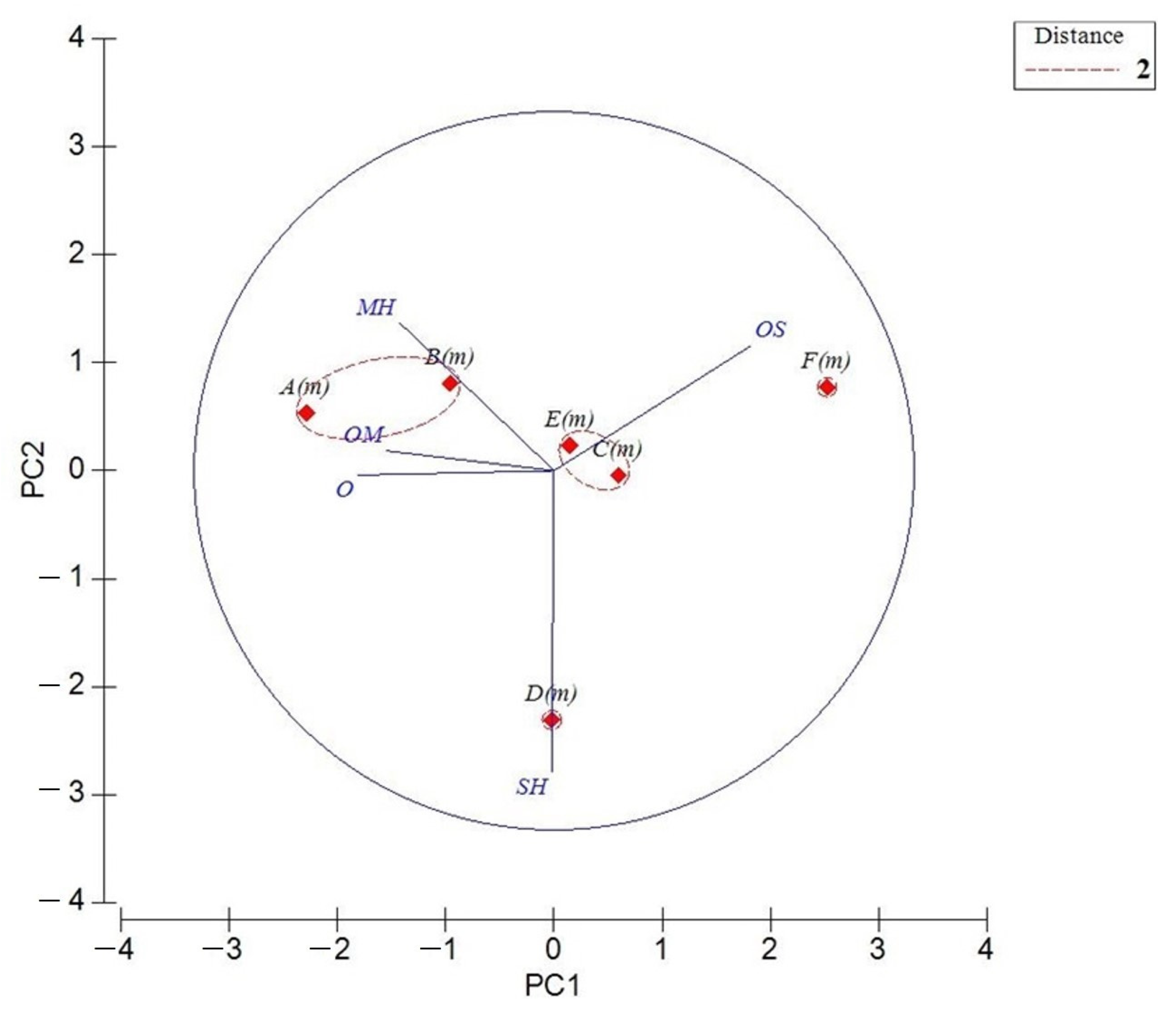
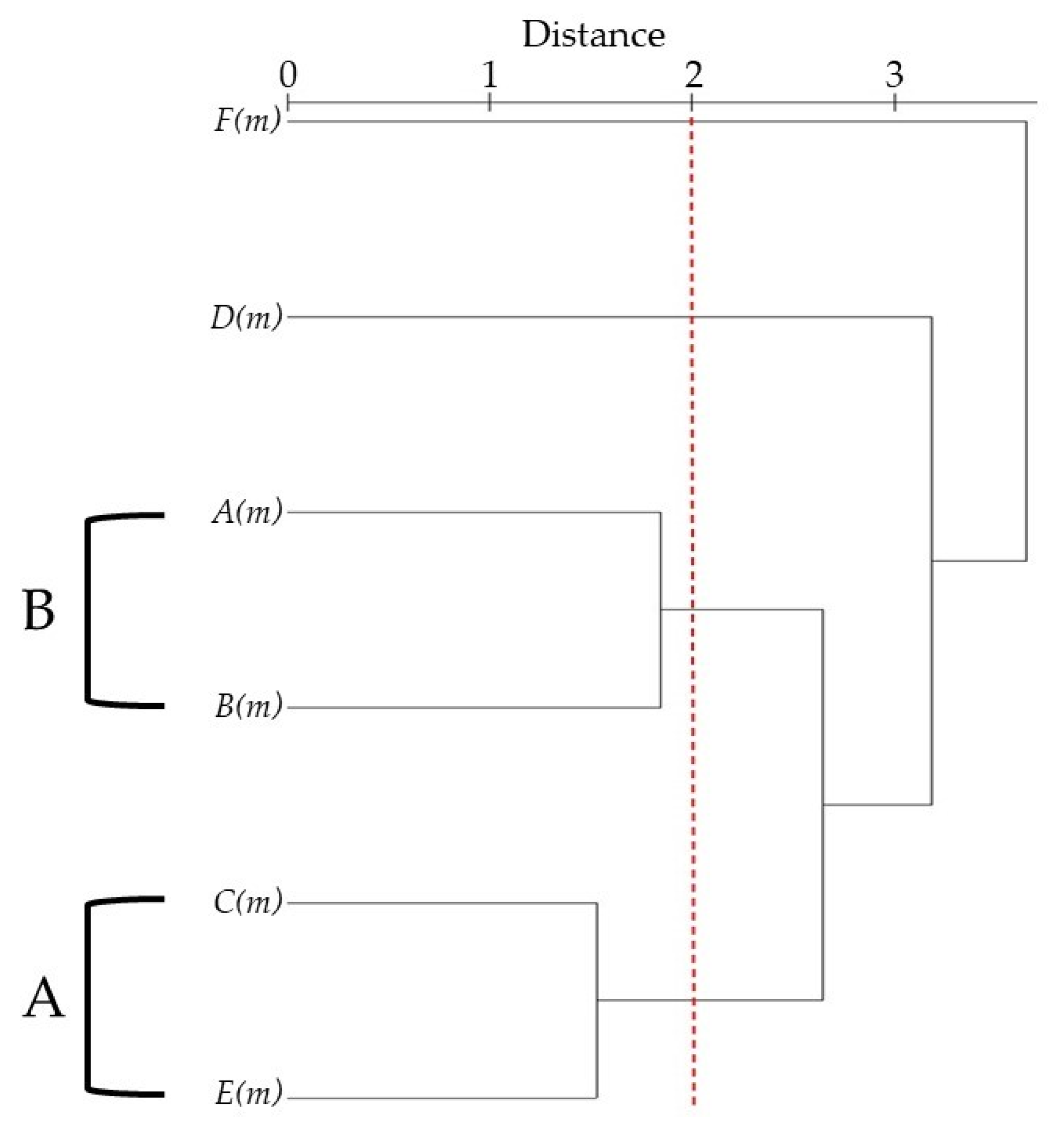
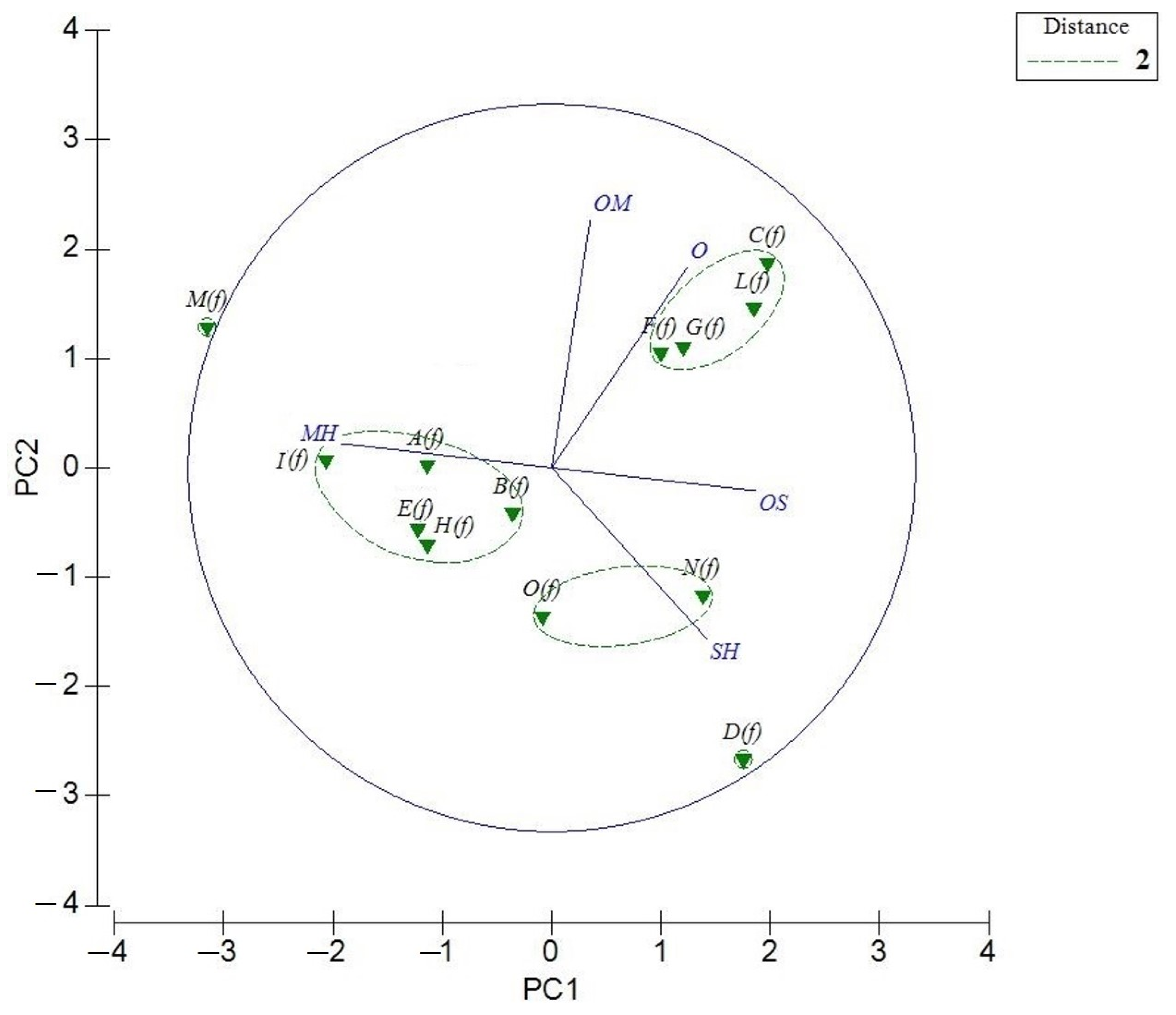
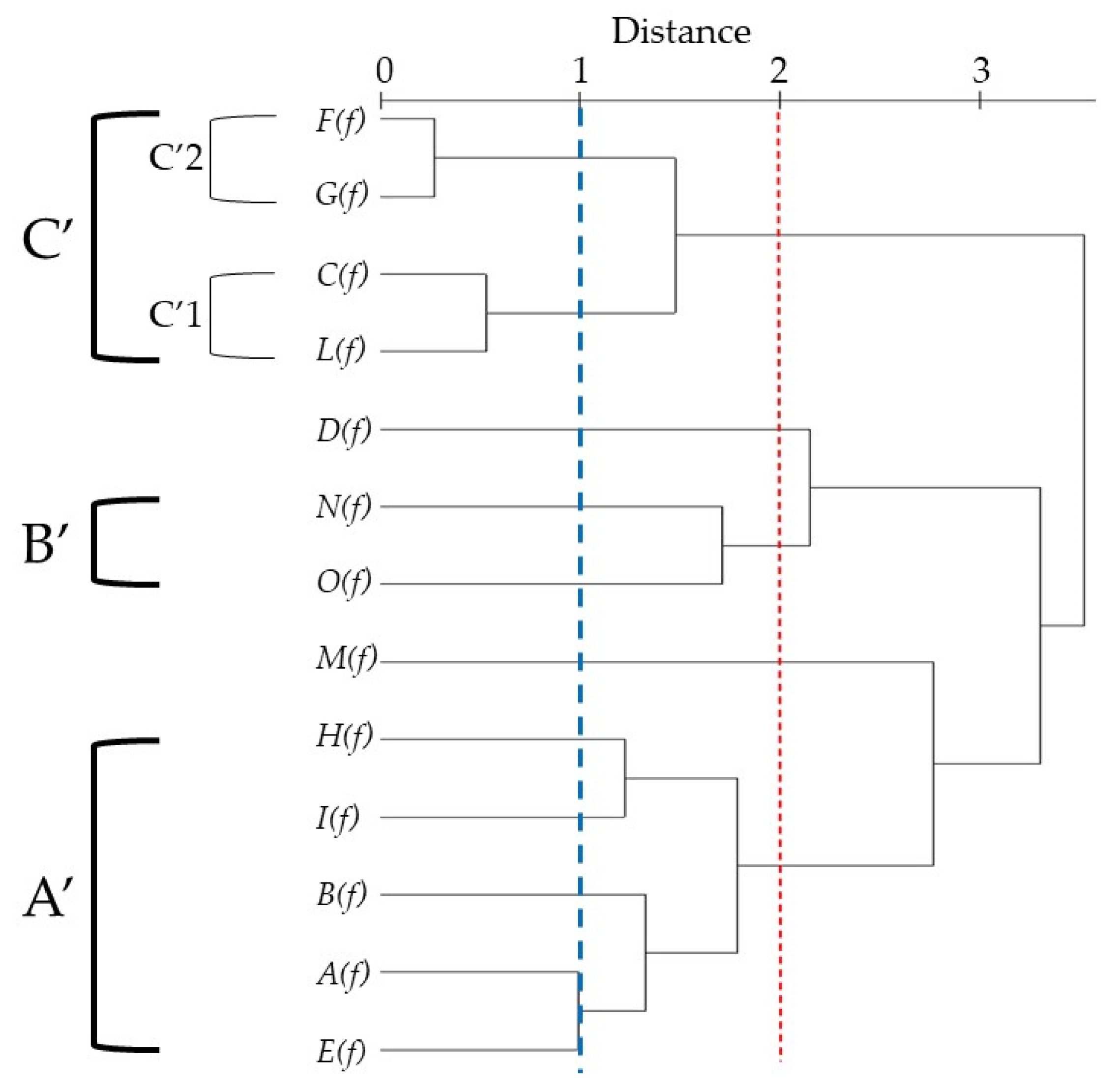

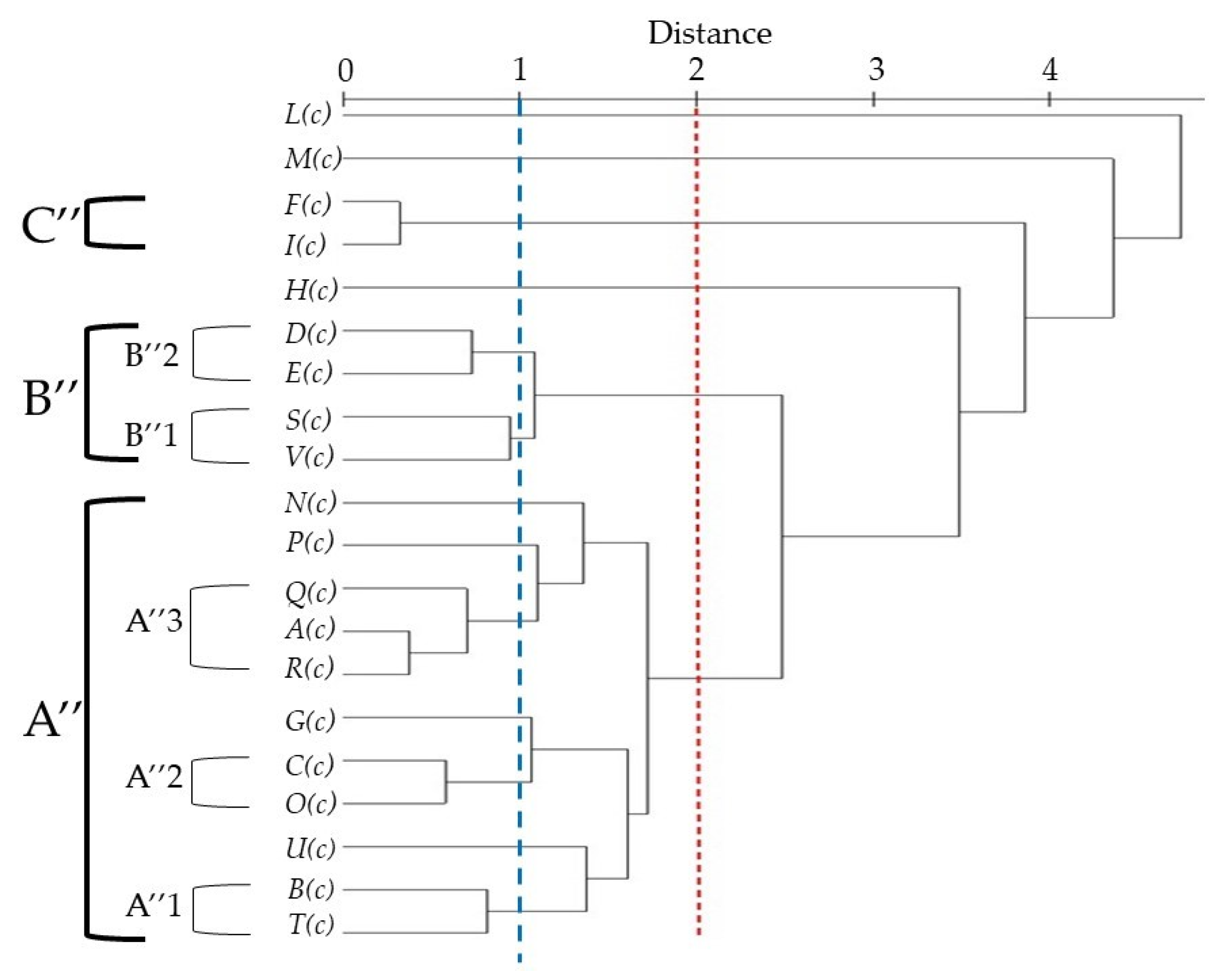
| Components Abbreviations | LRI a | LRI b | T. flavumO(f) | T. capitatumV(c) | T. montanumF(m) | |
|---|---|---|---|---|---|---|
| 1 | 1-Hexen-3-ol | 764 | 1244 | - | 0.1 | - |
| 2 | α-Pinene c | 937 | 1026 | 7.0 | 19.9 | 0.4 |
| 3 | Benzaldehyde c | 960 | 1478 | - | 1.9 | - |
| 4 | β-Pinene c | 974 | 1105 | 5.4 | 27.6 | - |
| 5 | Sabinene c | 976 | 1109 | - | - | 0.5 |
| 6 | 1-Octen-3-ol | 983 | 1447 | 0.1 | 1.0 | - |
| 7 | Myrcene c | 990 | 1152 | 0.2 | 8.6 | - |
| 8 | Sylvestrene | 1005 | 1200 | - | 16.6 | - |
| 9 | Limonene c | 1027 | 1199 | 12.7 | - | - |
| 10 | cis-Ocimene | 1038 | 1233 | 0.2 | - | - |
| 11 | trans-Ocimene | 1050 | 1256 | 1.0 | - | - |
| 12 | Linalool c | 1098 | 1546 | 0.3 | - | - |
| 13 | Nonanal c | 1101 | 1380 | 0.2 | - | 0.3 |
| 14 | Perillene | 1105 | 1429 | - | 0.1 | - |
| 15 | 3-Octyl acetate | 1118 | 1338 | 0.3 | - | - |
| 16 | (E,Z)-2,6-Dimethyl-2,4,6-octatriene | 1127 | 1345 | 0.5 | - | - |
| 17 | trans-Pinocarveol | 1132 | 1623 | - | 3.1 | - |
| 18 | δ-Verbenol | 1145 | 1652 | - | 1.1 | - |
| 19 | Isobutyl caproate | 1152 | 1333 | 0.2 | - | - |
| 20 | 2-Methylbutyl valerate | 1159 | 1324 | 0.6 | - | - |
| 21 | Terpinen-4-ol | 1176 | 1586 | - | 2.7 | - |
| 22 | p-Cymen-8-ol | 1184 | 1822 | - | 0.4 | - |
| 23 | Myrtenal | 1190 | 1627 | - | 1.1 | - |
| 24 | (E)-1-Octenyl acetate | 1193 | 1376 | 1.0 | - | - |
| 25 | Terpineol | 1197 | 1710 | - | 1.6 | - |
| 26 | Carvone c | 1199 | 1728 | - | 1.0 | - |
| 27 | Myrtenol | 1201 | 1751 | - | 0.7 | - |
| 28 | 3-Isopropylbenzaldehyde | 1204 | 1456 | - | 0.2 | - |
| 29 | cis-Carveol | 1231 | 1780 | - | 0.2 | - |
| 30 | Isoamyl caproate | 1239 | 1449 | 1.7 | - | - |
| 31 | Copaene | 1378 | 1474 | 0.3 | - | 2.3 |
| 32 | Isoledene | 1380 | 1489 | 1.7 | - | - |
| 33 | α-Funebrene | 1391 | 1492 | - | - | 4.5 |
| 34 | Sativene | 1400 | 1537 | - | 0.6 | - |
| 35 | α-Bourbonene | 1402 | 1521 | 1.7 | - | - |
| 36 | β-Caryophyllene c | 1419 | 1593 | 6.6 | - | 1.9 |
| 37 | β-Cedrene | 1422 | 1613 | - | - | 8.9 |
| 38 | α-Bergamotene | 1426 | 1543 | - | - | 2.1 |
| 39 | γ-Elemene | 1434 | 1627 | 0.5 | - | - |
| 40 | α-Cedrene | 1443 | 1587 | - | 1.0 | 0.5 |
| 41 | α-Humulene c | 1452 | 1608 | 3.1 | - | 2.5 |
| 42 | Isocaryophyllene | 1461 | 1655 | 0.1 | - | - |
| 43 | Dehydroaromadendrene | 1462 | 1621 | - | - | 3.0 |
| 44 | γ-Muurolene | 1471 | 1684 | 0.5 | - | - |
| 45 | Allo-aromadendrene | 1482 | 1638 | 0.8 | - | - |
| 46 | α-Curcumene | 1486 | 1767 | - | 0.5 | - |
| 47 | Allo-aromadendr-9-ene | 1496 | 1677 | - | - | 1.0 |
| 48 | β-Bisabolene c | 1509 | 1720 | 26.8 | - | - |
| 49 | γ-Cadinene | 1511 | 1766 | 5.5 | - | - |
| 50 | δ-Cadinene | 1525 | 1751 | - | - | 1.8 |
| 51 | α-Bisabolene | 1530 | 1762 | 0.4 | - | - |
| 52 | 9,10-Dehydro-Isolongifolene | 1531 | 1759 | - | - | 2.3 |
| 53 | β-Sesquiphellandrene | 1534 | 1754 | 0.3 | 0.5 | - |
| 54 | trans-Nerolidol c | 1554 | 2029 | 0.2 | - | - |
| 55 | Ledol | 1565 | 2033 | 0.4 | - | - |
| 56 | Caryophyllene oxide c | 1571 | 1999 | 3.1 | - | 2.8 |
| 57 | Palustrol | 1578 | 1931 | 0.2 | - | - |
| 58 | Globulol | 1580 | 2078 | 2.0 | - | 4.5 |
| 59 | Spathulenol c | 1584 | 2100 | 0.5 | - | 1.5 |
| 60 | τ-Cadinol | 1613 | 2167 | 0.4 | - | - |
| 61 | Humulane-1,6-dien-3-ol | 1616 | 2009 | 2.2 | - | - |
| 62 | Epiglobulol | 1629 | 2008 | 0.2 | 0.9 | 13.5 |
| 63 | Longifolenaldehyde | 1635 | 1944 | - | - | 14.5 |
| 64 | Cubenol | 1639 | 2055 | - | 1.2 | 2.8 |
| 65 | δ-Cadinol | 1641 | 2179 | - | - | 1.4 |
| 66 | Ledene oxide | 1646 | 2021 | - | - | 12.1 |
| 67 | α-Cadinol | 1653 | 2222 | 0.3 | t | - |
| 68 | β-Bisabolol | 1678 | 2196 | - | - | 3.9 |
| 69 | 8-Cedren-13-ol | 1690 | 2380 | - | - | 5.7 |
| 70 | α-Bisabolol | 1707 | 2224 | 1.5 | - | - |
| 71 | 6,10,14-Trimethyl-2-pentadecanone | 1830 | 2127 | - | - | 0.3 |
| 72 | Corymbolone | 1918 | 2355 | - | - | 0.5 |
| 73 | Manool c | 2036 | 2488 | 0.3 | - | - |
| 74 | Phytol c | 2125 | 2587 | 0.2 | - | 0.4 |
| Monoterpene hydrocarbons | 27.0 | 72.7 | 0.9 | |||
| Oxygenated monoterpenes | 0.3 | 12.2 | - | |||
| Sesquiterpene hydrocarbons | 48.3 | 2.6 | 30.8 | |||
| Oxygenated sesquiterpenes | 11.0 | 2.1 | 63.5 | |||
| Others | 4.6 | 3.0 | 0.7 | |||
| Total | 91.2 | 92.6 | 95.9 |
| Section Polium | T. montanum | ||||||||
|---|---|---|---|---|---|---|---|---|---|
| Origin | Abr | Parts | Compounds | MH | OM | SH | OS | O | Ref. |
| Croatia | A(m) | ap | germacrene D (17.2), β-pinene (12.9), β-caryophyllene (7.1), limonene (4.6), myrcene (4.2), linalool (3.6), β-bourbonene (3.4), hexacosane (3.4), pentacosane (3.3), tetracosane (3.1) | 24.4 | 12.4 | 35.1 | 5.1 | 22.5 | [25] |
| Turkey | B(m) | ap | sabinene (11.3), δ-cadinene (6.3), germacrene D (5.8), α-copaene (5.7), (E)-β-farnesene (5.5), τ-cadinol (5.4), α-pinene (5.2), linalool (3.2), β-pinene (3.1) | 26.5 | 9.0 | 33.5 | 13.1 | 8.8 | [26] |
| Serbia-Mont Mt. Orjen | C(m) | ap | germacrene D (15.0), α-pinene (12.4), β-eudesmol (l0.l), β-caryophyllene (6.9), β-pinene (4.8), δ-cadinene (4.5), γ-cadinene (4.1), cadinol (3.6), bicyclogermacrene (3.5) | 21.2 | 1.8 | 48.6 | 24.1 | 1.4 | [27] |
| Serbia, Jadovnik | D(m) | ap | δ-cadinene (17.2), β-selinene (8.2), α-calacorene (5.0), cadalene (4.9), caryophyllene (4.3), copaene (4.2), torreyol (3.9), terpine-4-ol (3.9), cadina-1,4-diene (3.4), β-sesquiphellandrene (3.3), γ-curcumene (3.2), τ-cadinol (3.1) | 1.1 | 6.5 | 74.2 | 7.0 | 9.2 | [28,29] |
| Serbia, Jabura | E(m) | ap | δ-cadinene (8.1), β-caryophyllene (5.1), τ-muurolol (4.2), α-pinene (4.0), dehydrosesquicineole (3.9), γ-cadinene (3.6), α-cadinol (3.5) | 7.9 | 14.1 | 39.3 | 33.4 | 3.7 | [30] |
| Section Polium | T. capitatum | ||||||||
| Algeria, Boussaada | A(c) | ap | τ-cadinol (18.3), germacrene D (15.3), β-pinene (10.5), carvacrol (5.5), bicyclogermacrene (5.5), α-pinene (4.1), limonene (3.1) | 22.0 | 12.4 | 31.2 | 25.5 | 0 | [31] |
| Algeria, Bouira | B(c) | ap | germacrene D (25.0), β-pinene (11.3), bicyclogermacrene (10.4), spathulenol (5.8), limonene (4.0), τ-cadinol (3.5) | 23.1 | 1.3 | 43.7 | 13.5 | 0.1 | [32] |
| Bulgaria | C(c) | ap | β-pinene (26.8), germacrene D (17.7), α-pinene (9.3), limonene (6.4), E-nerodilol (4.6), bicyclogermacrene (4.0), myrtenal (3.3), spathulenol (3.2) | 45.7 | 17.2 | 27.7 | 5.8 | 0 | [33] |
| Corsica, Bustanico | D(c) | ap | α-pinene (24.1), β-pinene (9.2), α-thujene (8.1), terpinen-4-ol (6.2), limonene (5.2), sabinene (4.1), p-cymene (4.0) | 59.3 | 29.6 | 4.4 | 4.8 | 0.8 | [34,35] |
| Corsica, Corte | E(c) | ap | α-pinene (28.8), β-pinene (7.2), p-cymene (7.0), α-thujene (5.0), terpinen-4-ol (4.6), p-cymene-4-ol (3.0), limonene (3.0) | 56.2 | 18.5 | 1.5 | 2.9 | 0.4 | [36] |
| Greece, Crete | F(c) | ap | caryophyllene (9.8), carvacrol (10.1), torreyol (7.6), α-cadinol (4.5), cis-verbenone (3.7), germacrene D (3.1), α-humulene (3.8), δ-cadinene (3.1), E-nerolidol (3.0) | 1.2 | 13.6 | 32.7 | 23.1 | 22.9 | [37] |
| Greece, Athens | G(c) | ap | α-pinene (14.8), β-pinene (12.8), β-caryophyllene (11.3), τ-cadinol (7.7), myrcene (5.5), germacrene D (4.8), sabinene (4.7), α-humulene (3.3), α-cadinol (3.2), limonene (3.1) | 44.2 | 9.2 | 25.1 | 21.2 | 0 | [38] |
| Greece, Kos | H(c) | lv + fl | germacrene D (53.7), (E)-β-farnesene (10.0), bicyclogermacrene (9.1), spathulenol (3.2), limonene (3.1) | 5.5 | 0 | 79.9 | 3.2 | 0 | [39] |
| Greece, Crete | I(c) | ap | caryophyllene (10.1), carvacrol (9.6), torreyol (6.5), caryophyllene oxide (5.0), α-cadinol (4.0), cis-verbenone (4.0) germacrene D (3.9), α-humulene (3.4), δ-cadinene (3.1), germacrene D-4-ol (3.0) | 1.2 | 15.0 | 33.9 | 21.3 | 21.0 | [40] |
| Iran | L(c) | ap | α-cadinol (46.2), caryophyllene oxide (25.9), epi-α-muurolol (8.1), cadalene (3.7) | 0.1 | 2.5 | 3.7 | 92.4 | 1.3 | [41] |
| Morocco | M(c) | ap | endo-borneol (33.0), δ-cadinene (19.6), bornyle acetate (15.6), α-terpineol (12.0), α-thujol (10.9) | 0 | 74.1 | 20.6 | 0.3 | 3.7 | [42] |
| Portugal, Fonte Coberta | N(c) | ap | τ-cadinol (5.5), p-menthan-3-one (7.7), β-caryophyllene (4.8), germacrene D (3.5), terpine-4-ol (3.5), α-cadinol (3.2), δ-cadinene (3.0) | 11.2 | 33.0 | 24.3 | 14.9 | 0.4 | [43] |
| Portugal, Rabaçal | O(c) | ap | sabinene (11.2), β-pinene (10.3), α-pinene (7.7), δ-cadinene (4.9), β-caryophyllene (3.8), germacrene D (3.6), myrcene (3.5) | 43.9 | 24.9 | 23.2 | 7.5 | 1.2 | [43] |
| Portugal, Cantanhede | P(c) | ap | τ-cadinol (24.1), α-cadinol (9.8), γ-cadinene (5.5), δ-cadinene (3.7), δ-verbenol (3.5), β-caryophyllene (3.3), caryophyllene oxide (3.1) | 7.3 | 19.8 | 23.0 | 39.7 | 0.4 | [43] |
| Portugal, Cantanhede | Q(c) | ap | δ-cadinene (7.5), β-caryophyllene (5.4), α-cadinol (4.2), germacrene D (3.5), τ-cadinol (3.2), terpine-4-ol (3.0) | 7.6 | 19.7 | 32.2 | 23.4 | 0.8 | [43] |
| Portugal, Serra D′Aire | R(c) | ap | δ-cadinene (9.8), β-pinene (5.0), β-caryophyllene (4.6), α-cadinol (4.6), sabinene (3.1), τ-cadinol (3.0) | 17.0 | 12.5 | 33.2 | 20.4 | 1.0 | [43] |
| Sardinia, Porticciolo | S(c) | ap | limonene (20.6), α-pinene (20.4), E-nerolidol (16.7), β-pinene (7.6), myrcene (7.5) | 62.8 | 11.4 | 3.8 | 16.7 | 0 | [44] |
| Sardinia, Gennargentu | T(c) | ap | limonene (17.2), α-pinene (12.5), α-trans-bergamotene (12.2), humulene epoxide II (9.2), δ-cadinene (7.7), β-calacorene (5.6), β-pinene (4.5) | 40.2 | 4.1 | 37.8 | 10.0 | 0 | [44] |
| Serbia | U(c) | ap | germacrene D (31.8), linalool (14.0), β-pinene (10.7), β-caryophyllene (8.8), bicyclogermacrene (6.2), α-pinene (3.5) | 20.2 | 17.3 | 55.1 | 4.5 | 0.2 | [43] |
| Section Chamaedrys | T. flavum | ||||||||
| Croatia, Dalmatia | A(f) | ap | α-pinene (17.3), β-caryophyllene (15.8), β-pinene (11.2), allo-aromadendrene (9.2), limonene + 1,8-cineole (6.2), α-cubebene (4.3), γ-terpinene (3.5), δ-cadinene (3.2) | 42.5 | 7.0 | 43.4 | 4.3 | 1.8 | [45] |
| Croatia, Split | B(f) | ap | β-caryophyllene (23.1), germacrene-D (15.3), α-pinene (10.5), β-pinene (8.4), limonene (7.9), n-amyl-isovalerate (3.7) | 28.4 | 3.4 | 50.8 | 5.0 | 9.7 | [25] |
| Greece, Mt Pileum | C(f) | ap | caryophyllene (12.2), 4-vinyl-guaicol (9.7), caryophyllene oxide (7.9), α-humulene (6.0), linalool (3.4), β-bourbonene (3.1) | 1.3 | 9.1 | 39.0 | 15.5 | 26.8 | [37] |
| Iran | D(f) | lv | β-caryophyllene (30.6), germacrene-D (21.3), α-humulene (8.4), τ-cadinol (6.9), δ-cadinene (4.9), trans-α-bergamotene (4.8), spathulenol (4.5), caryophyllene oxide (3.8), β-bisabolene (3.1) | 0 | 0 | 82.2 | 17.7 | 0 | [46] |
| Montenegro, River Moraca | E(f) | ap | β-bisabolene (35.0), α-pinene (17.5), β-pinene (11.5), limonene (6.4), β-caryophyllene (5.4), α-humulene (3.6) | 38.8 | 4.4 | 50.1 | 1.5 | 2.9 | [47] |
| Italy, Marche | F(f) | ap, dry | (Z,E)-α-farnesene (11.5), linalool (7.6), β-bisabolene (7.5), (E)-β-farnesene (7.3), 11-αH-himachal-4-en-1-β-ol (6.2), β-caryophyllene (5.7), germacrene D (5.5), α-pinene (5.3), β-pinene (4.5), limonene (3.5) | 14.2 | 8.9 | 48.5 | 11.1 | 16.6 | [47] |
| Italy, Marche | G(f) | ap, fresh | (Z,E)-α-farnesene (14.9), 11-αH-himachal-4-en-1-β-ol (10.1), germacrene D (6.6), (E)-β-farnesene (5.7), β-caryophyllene (5.1), β-bisabolene (5.0) | 11.5 | 9.4 | 49.4 | 12.2 | 16,5 | [47] |
| Italy, Liguria | H(f) | ap | α-pinene (19.0), germacrene D (11.9), β-pinene (10.6), limonene (9.0), α-bulnesene (8.9), (Z,E)-farnesolo (4.7), (E)-β-farnesene (3.3) | 46.5 | 1.2 | 35.6 | 7.0 | 5.8 | [48] |
| Italy, Tuscany | I(f) | ap | α-pinene (22.6), β-pinene (15.8), limonene (13.2), germacrene D (6.9), (E,E)-α-farnesene (4.8) | 58.5 | 2.7 | 19.1 | 3.6 | 6.0 | [48] |
| Greece, Zakynthos | L(f) | ap | caryophyllene (13.5), caryophyllene oxide (8.5), 4-vinyl-guaiacol (6.0), α-humulene (5.0), hexahydrofarnesyl acetone (3.4), α-copaene (3.3) | 0.5 | 7.5 | 41.3 | 14.4 | 26.0 | [49] |
| Corsica | M(f) | ap | α-pinene (21.9), limonene (20.0), β-pinene (18.1), (Z)-α-ocimene (15.5) | 80.7 | 6.7 | 2.3 | 0.8 | 4.9 | [35] |
| Tunisia | N(f) | ap | β-caryophyllene (32.5), α-humulene (17.8), germacrene D (6.0), caryophyllene oxide (4.9), (Z)-γ-bisabolene (4.0) | 0.2 | 2.0 | 68.0 | 11.9 | 11.1 | [50] |
Publisher’s Note: MDPI stays neutral with regard to jurisdictional claims in published maps and institutional affiliations. |
© 2021 by the authors. Licensee MDPI, Basel, Switzerland. This article is an open access article distributed under the terms and conditions of the Creative Commons Attribution (CC BY) license (http://creativecommons.org/licenses/by/4.0/).
Share and Cite
Catinella, G.; Badalamenti, N.; Ilardi, V.; Rosselli, S.; De Martino, L.; Bruno, M. The Essential Oil Compositions of Three Teucrium Taxa Growing Wild in Sicily: HCA and PCA Analyses. Molecules 2021, 26, 643. https://doi.org/10.3390/molecules26030643
Catinella G, Badalamenti N, Ilardi V, Rosselli S, De Martino L, Bruno M. The Essential Oil Compositions of Three Teucrium Taxa Growing Wild in Sicily: HCA and PCA Analyses. Molecules. 2021; 26(3):643. https://doi.org/10.3390/molecules26030643
Chicago/Turabian StyleCatinella, Giorgia, Natale Badalamenti, Vincenzo Ilardi, Sergio Rosselli, Laura De Martino, and Maurizio Bruno. 2021. "The Essential Oil Compositions of Three Teucrium Taxa Growing Wild in Sicily: HCA and PCA Analyses" Molecules 26, no. 3: 643. https://doi.org/10.3390/molecules26030643
APA StyleCatinella, G., Badalamenti, N., Ilardi, V., Rosselli, S., De Martino, L., & Bruno, M. (2021). The Essential Oil Compositions of Three Teucrium Taxa Growing Wild in Sicily: HCA and PCA Analyses. Molecules, 26(3), 643. https://doi.org/10.3390/molecules26030643








